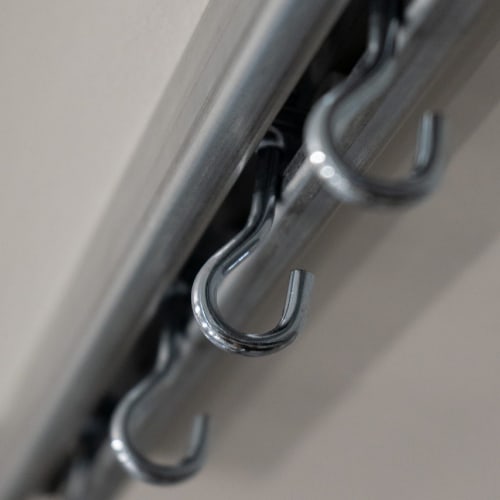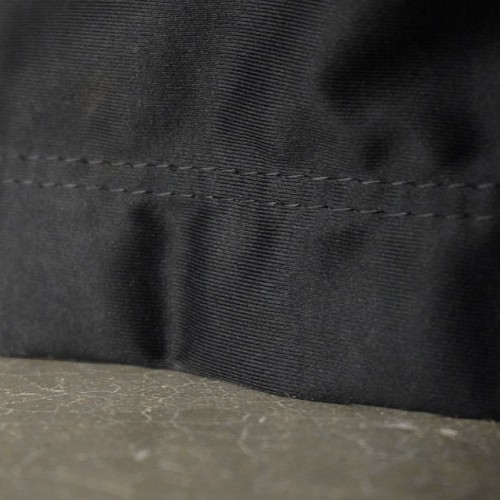The side curtains and backdrops enclosing a golf simulator setup take quite a beating from powerful shots, so durability is a prime factor. But with varied densities and fabric blends to pick from, determining adequate weight and thickness for these netting barriers can get confusing.
Side curtains need to effectively absorb average hits without failing or deforming. Our guide explores the ideal density, breathability and weight for different simulator curtain fabrics. Compare durable but breathable polyester blends against heavier Oxford canvas weights up to 22oz for high-traffic commercial setups. Analyze weight vs air permeability to pick netting suited for your hitting intensity and environmental conditions.
Read on for recommendations on characteristics like UV resistance, blackout properties, tear-resistance, and standard weights for side curtains and backdrops based on home vs. commercial simulator use cases.
Purpose and Function of Side Curtains
Side curtains in golf simulators have three main roles:
- Prevent golf balls from escaping the simulator enclosure – The curtains form a perimeter barrier to keep golf balls contained within the space, stopping them from damaging walls or escaping.
- Provide backdrop for simulator screen/projection – Simulator software projects high-resolution virtual golf courses onto the enclosure walls and curtains. A seamless backdrop improves immersion in the simulation.
- Block outside light for optimal visualization – Ambient light can wash out projected images. Blocking external light sources with opaque curtain materials creates ideal conditions for simulator visualization and playability.
Factors Determining Side Curtain Weight

The required thickness and weight capacity of the side curtains depend on the following elements:
Size/dimensions of the simulator enclosure
Larger bays need stronger curtains across longer horizontal spans to avoid sagging under their own weight. The height also plays a role. The larger the enclosure, the larger and heavier the curtains will be.
Number of curtain layers
Using multiple layered curtains improves light blocking and durability. However, this increases the overall weight of the curtains, which requires ceiling support.
Durability considerations
Withstanding golf ball strikes and regular use without damage also requires adequate curtain thickness/density. A lighter curtain using fewer layers won’t be effective in stopping high-velocity balls, compared to heavier options.
Getting the curtain weight right for a simulator’s dimensions makes installation easier while delivering the required functionality and longevity.
Recommended Side Curtain Weights

When selecting curtain materials for a golf simulator enclosure, the weights need to match the intended simulator size and usage levels. Heavier curtains improve durability and functionality. For more detailed guidance on building your own golf simulator, including considerations for space, budget, and equipment selection, check out our informative article on how to build a golf simulator.
For Home Simulators (10 x 15 Feet)
For residential spaces, single-user golf simulators typically have a 10′ x 15′ enclosure. Good options are:
- Single Layer: 14-16 oz reinforced vinyl – This provides decent durability for lower use frequency while being cost-effective.
- Double Layer: Using 14-16 oz reinforced vinyl combined with a 7-8 oz blackout lining – The added layer improves light blocking and protection against strikes.
For Commercial Simulators (15 x 25 Feet)
Public golf simulator facilities need curtains with enhanced durability; the recommended curtains to use are as follows:
- Single Layer: 18 oz coated vinyl curtain – This thicker material resists damage from extensive use by multiple golfers over extended periods of time.
- Double Layer: You can use the same 18 oz coated vinyl curtain, along with a 10-12 oz blackout backing layer. This combination maximizes the curtain longevity for high-traffic commercial spaces.
Other Considerations
In addition to the factors above, the strategic placement of thicker curtain sections can optimize weight distribution. For instance, it is recommended to use heavier materials higher up where most golf ball impacts occur. You can also add frame reinforcements at stress points like enclosure corners. The frame should also be designed to evenly distribute curtain weight across the walls to avoid stressing one or more sides of the structure.
To explore a wider range of high-performance curtains and their weight distribution properties, check out our golf simulator curtains buying guide here.
Getting curtain weights right for the simulator size and usage levels simplifies installation while providing the needed functionality over time. Proper layering also improves light blocking for the visualization system.
Installation and Maintenance Best Practices
Properly installing side curtains and maintaining them over time is key to getting the most out of your golf simulator. Following best practices will keep the curtains functioning properly for years.
Hanging Methods

The weight of simulator curtains should be distributed evenly across the full width of the enclosure using multiple secure mounting points. This prevents too much stress from being placed on any single area.
Allowing for adjustable hanging heights also enables tuning the enclosure as needed. Having some ability to raise or lower side curtains provides more flexibility.
Some common hanging methods are:
- Ceiling-mounted bolts with carabiners
- Tension rods across upper walls
- Industrial-strength Velcro strips
Each has pros and cons to evaluate against your simulator setup.
Durability and Care

Protecting curtains from wayward golf shots extends their usable life. Clear vinyl panels hung a foot or two in front can shield side curtains from ball strikes.
Establishing maintenance routines is also important. Frequently brush off loose dirt to prevent abrasion, and try to clean any dirty spots using gentle, non-bleach detergents. In addition, you should avoid excessive heat, moisture and sunlight exposure to increase the materials’ lifespan.
When in doubt, it is highly recommended to consult the manufacturer’s care instructions for your specific curtain fabric. You may also contact a professional to ensure you don’t ruin the curtains using inappropriate substances.
Working With Contractors
Hiring an experienced golf simulator installer is advisable to get everything hung properly on the first try. They have the right lifting equipment and techniques tailored to these heavyweight curtains.
For fully custom enclosures, get quotes from multiple contractors on materials, fabrication and installation. Evaluate their experience working with high-end simulators.
Hiring a professional will substantially raise your financial investment, but it ensures everything is installed properly, avoiding any potential issues down the road.
Balancing Weight, Durability and Cost
Finding the optimal balance between curtain weight, durability, and budget is key for any golf simulator project. Prioritizing the factors below helps strike that balance.
Prioritizing Long-Term Functionality
Heavier and layered curtain materials generally withstand strikes and usage better over many years. So maximizing long-term playability should be the priority, even if it increases upfront expenses.
Consider the expected simulator lifetime based on the number of users, usage frequency, and replacement difficulty. Budgeting a little more for super durable curtains now saves money later.
Budgeting Considerations

The total budget available impacts choices between single vs. double layer curtains, basic vs. premium fabric grades, DIY vs. professional installation, etc. Outline must-have functionality, then allocate budget across curtains, equipment, installation, and other costs accordingly.
Also factor in ongoing maintenance fees for cleaning, inspection and periodic replacement.
Future-Proofing Your Simulator
Technology keeps advancing, so leave room to improve your simulator over 5-10 years. Using adjustable hanging systems and removable/replaceable curtains makes upgrading enclosure materials, dimensions or layout easier.
Anticipate how needs might change. Commercial simulators may expand user capacity. Home users may move spaces, requiring adaptation. Keep flexibility in mind while building your system.
For adaptable and space-conscious options, explore our guide to screens and enclosures. It showcases frameworks that cater to evolving needs, from modular pods to expandable bays, helping you design a future-proof simulator setup.
Frequently Asked Questions
Below are answers to some common questions about selecting, installing and caring for golf simulator side curtains:
How often do side curtains need replacing?
With proper installation and care, quality side curtains can last 5+ years in home simulators, and 2-3 years in high-traffic commercial bays. Inspect the curtains annually for wear and replace them as needed.
Should I buy curtains pre-made or get them custom fabricated?
Pre-made curtains are cheaper if standard sizes fit your space. Going custom-made allows for optimizing the weight and durability balance for your exact simulator dimensions.
What’s the easiest way to hang heavy curtains?
Ceiling-mounted bolts with carabiners evenly distribute weight across the entire width. These make raising/lowering the curtains easy, too.
How do I protect curtains from club damage?
Layered clear vinyl “shields” provide inexpensive protection. Also, you may budget for replacement panels.
Can I clean curtains with bleach or harsh chemicals?
It is highly recommended to avoid harsh chemicals and bleach; you should spot clean gently using only non-bleach detergents recommended by the manufacturer to avoid any damage.
Should I hire pros or DIY the installation?
Hiring experienced installers ensures proper hanging techniques and safety protocols and reduces liability. If you have the necessary skills and tools to go DIY, you can save some money to invest in better equipment.
Does the curtain weight match the simulator size?
Yes, larger simulator enclosures need heavier curtains rated for those dimensions. Matching weight capacity to sim space is advisable.
Final Thoughts
The side curtains and backdrops enclosing your golf simulator setup see repetitive impact from golf shots daily, making durability a prime factor. With the right blend of weight, density and tear resistance, simulator netting will handle years of regular use from amateur through pro-level swing speeds. While very lightweight curtains may save on costs upfront, the expense of continually replacing torn panels adds up over time.
Be sure to follow manufacturer guidelines for safely hanging these heavyweight curtains using steel cabling and solid anchor points across the entire upper framework.
If you have questions or comments, please contact us.





